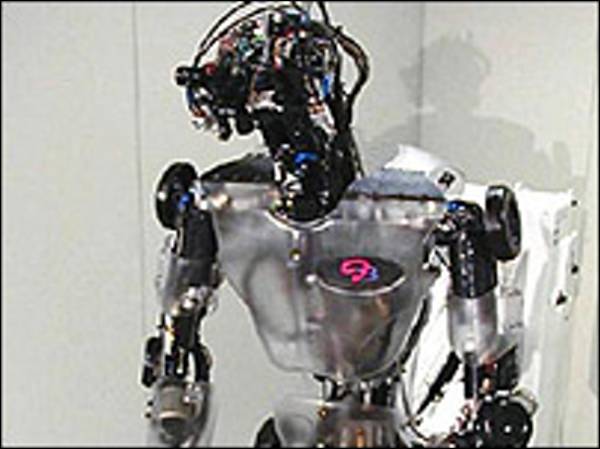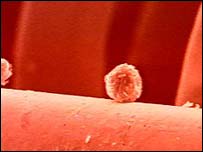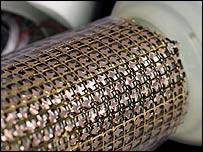
SEPTEMBER 2005

POEM
STEM CELL MILESTONES
(unscanned!)
1960s: Research begins on stem cells taken from adult
tissue
1968: Adult stem cells used to treat immunodeficient
patient ,aids.
1998: US scientists grow stem cells from human embryos
and germ cells, establishing cell lines still in use
2001: Embryonic stem cell turned into a blood cell,
sickle blades?
2004: South Korean scientists clone 30 human embryos and
develop them over several days
2005: Korean team develops stem cells tailored to match
individual patients
ways
* * * * * * * * *
Action robot to copy human brain(note my magic number!)
How the human brain makes certain decisions are to be adapted to build a new robot which will think for itself.
Aberystwyth University academics are working on the machine which they hope will recognise objects and retrieve them using an arm and cameras for eyes.
However, it is unclear at present what it could be used for ultimately.
Scientists said they aimed to "unravel" how a part of the brain worked and would then use that information to develop the machine.
Led by Professor Mark Lee, the team from Aberystwyth is joined by academics from six other universities on the five-year project.
Financial backing worth some £1.9m has come from the Engineering and Physical Sciences Research Council - Aberystwyth's share is £470,000.
Most robots are programmed to make certain decisions, but are unable to think for themselves.
According to Prof Lee, the project's purpose was to try to "unravel" the way in which the brain worked and to then build a robot that could "think" for itself.
"Humans and animals adapt their actions according to what surrounds them, and are able to do several things at the same time and learn from their mistakes," he said.
"With this project we hope to solve this problem of multi-tasking by using our knowledge of how the brain works."
The robot would also be able to detect items, assess their significance and prioritise, focusing on the most important.
"Our understanding of how the brain works is also key to the next stage which will involve teaching the robot how to react to things that change around it.
"For example, something which could potentially distract it from the task it has been set. It will also be able to learn from its mistakes just as humans do.
"Once the robot has been constructed we will then stand back and ask the question 'what general features of the model gave it its ability to integrate its behaviours successfully?'
"By doing this we hope to be able to transfer our work into a wider range of robots designed for many different tasks."
The full project team is made
up of mathematicians, control engineers, computer
modellers and neuroscientists from universities including
Bristol, Sheffield, Oxford and Cambridge.

Scientists make nerve stem cells.
The world's
first pure batch of nerve stem cells made from human stem
cells has been created at the University of Edinburgh,
scientists have reported.
It is hoped the newly-created cells will eventually help scientists find new treatments for diseases such as Parkinson's and Alzheimer's.
BBC science
correspondent Pallab Ghosh said the cells should help
researchers test the effectiveness of new drugs. 
Stem cells are "master" cells that can become many kinds of tissue.
Nerve stem cells are those which help build the brain and central nervous system.
"In terms of the possibility of using the cells for transplantation, that's a much more difficult and longer term thing and I think there we're talking more of the five to ten year range."
Previous attempts at creating the nerve cells have produced contaminated samples that have not been scientifically useful.
The breakthrough comes three months after scientists at Newcastle University announced they had successfully produced a cloned embryo using donated eggs and genetic material from stem cells.
It was the first time a human cloned embryo had been created in Britain.
Critics say these "cloning" techniques are unethical.

Thin skin will help Robots feel !!!
Japanese researchers have developed a flexible artificial skin that could give robots a humanlike sense of touch.
The team manufactured a type of "skin" capable of sensing pressure and another capable of sensing temperature.
These are supple enough to wrap around robot fingers and relatively cheap to make, the researchers have claimed.
The University of Tokyo team describe their work in the latest issue of the journal Proceedings of the National Academy of Sciences.
The researchers explain how pressure-sensing and temperature-sensing networks can be laminated together, forming an artificial skin that can detect both properties simultaneously.
Takao Someya, lead author on the latest research, previously developed a form of artificial skin capable of sensing pressure.
But the ability to sense
temperature as well allows the scientists to more closely
imitate the functions of human skin.
functions of human skin.
Someya and his colleagues used electronic circuits as pressure sensors and semiconductors as temperature sensors. They embedded these sensors in a thin plastic film to create networks of sensors.
Organic materials
The transistors used in the circuits and the semiconductors both use "organic" materials based on chains of carbon atoms.
This makes them mechanically flexible and relatively inexpensive to fabricate.
"Both of those characteristics sound compelling. The material sounds like it could have lots of functions," Dr Douglas Weibel, of the department of chemistry and chemical biology at Harvard University told the BBC News website.
"The materials they're using may not be completely novel but the integration appears to be something new."
The University of Tokyo scientists say their breakthrough has the potential to improve how robots will function in the real world.
And they add that there is no need to stop at simply imitating the functions of human skin.
"It will be possible in the near future to make an electronic skin that has functions that human skin lacks," the researchers write in Proceedings of the National Academy of Sciences.
Future artificial skins could incorporate sensors not only for pressure and temperature, but also for light, humidity, strain or sound, they add.

culled from the BBC
Castle Computer Corp creates first
Artificial Intelligence.
Sun Aug 14, 7:00 AM ET
http://news.yahoo.com/news?tmpl=story&u=/prweb/20050814/bs_prweb/prweb267050
Castle Computer Corp of Lynden, WA has completed a 20
year program funded in part by DARPA, Army Intelligence
and several private grants.
Codenamed 'TED', a newborn Artificial Intelligence which
has passed all Turing tests given to it.
The new intelligence appears to be aware of itself and
its surroundings in a way only animals and humans have
previously been known to.
Castle Computer Corp